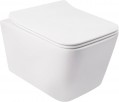Bowl shape
The overall shape of the toilet bowl.
The choice of this parameter largely depends on the aesthetic preferences of the user and the overall design of the bathroom; however, the shape of the bowl is quite practical. So, in our time, the most common is
semicircular models, where the rear edge of the bowl is made straight, and the rest - rounded (oval, egg-like, etc.). This shape not only looks good - it is convenient to sit on, and the absence of angles (at least in front of the bowl) facilitates cleaning and reduces the risk of hitting the toilet with your foot. In addition, material on such a bowl requires less than a rectangular product of similar dimensions - as a result, semi-circular toilet bowls are relatively inexpensive and light.
The rectangular shape, in turn, gives a larger support area, which is important for users of large physique. However, toilet bowls
classical rectangular shape are rare (due to the high cost of production, as well as for some other reasons). Much more common are variations on this topic - the bowls
, with bevelled (rounded) corners, as well as
, with the front end shaped arc.
Toilet material
—
Sanitaryware(“sanitary faience”). The most common material for modern toilets, at a low cost, has a neat appearance, is durable and reliable. The main disadvantage is the porous structure, which contributes to the accumulation of dirt and odors (although recently technologies have been applied to eliminate this disadvantage). The service life of such material in modern toilets can reach 40 years.
—
Sanfarfor(“sanitary porcelain”). Like sanitary ware, it belongs to ceramic materials, however, with similar strength and appearance, it absorbs water and dirt much less easily, due to which it has a longer service life - up to 60 years. However, sanitary porcelain is also more expensive.
- Stainless steel. The key advantage of “stainless steel” is its high strength: this material can easily withstand even strong impacts that can crack sanitary porcelain or sanitaryware. On the other hand, such toilets are not cheap, despite the fact that the mentioned strength in reality is not needed so often. Therefore, it makes sense to pay attention to this option in cases where reliability and resistance to damage are of key importance - for example, if plumbing fixtures are purchased for a stadium, bar, etc., and must be vandal-resistant.
- Ceramics. These or other types of ceramics that either do not belong to the sanitary porcelain or sanitary ware described above, or represent specific v
...arieties of these materials. The specific features of ceramic toilets should be clarified separately; however, for the most part these are quite advanced and high-quality products.
Moreover, each of the listed materials may additionally have a special antibacterial toilet coating that prevents the growth and reproduction of bacteria. It significantly improves the hygiene of use, but affects the price.Country of origin
The country of origin of the brand under which the toilet is marketed. Nowadays, on sale you can mainly find products from such countries (in alphabetical order):
Belgium,
Germany,
India,
Spain,
Italy,
Poland,
Turkey,
France,
Czech Republic,
Switzerland,
Sweden,
Japan.
There are many stereotypes related to how the origin of goods from a particular country affects their quality. However, in general, these stereotypes are unfounded. Firstly, this paragraph does not indicate the actual place of manufacture of the toilet bowl, but the "homeland" of the trademark (or the location of the manufacturer's headquarters); production facilities may be located in another country. Secondly, the actual quality of the product depends not so much on geography, but on the organization of processes within a particular company. So when choosing, it is best to focus not so much on the "nationality" of the toilet, but on the overall reputation of a particular brand. And paying attention to the country of origin makes sense if you fundamentally want (or do not want) to support a manufacturer from a
...certain state.
